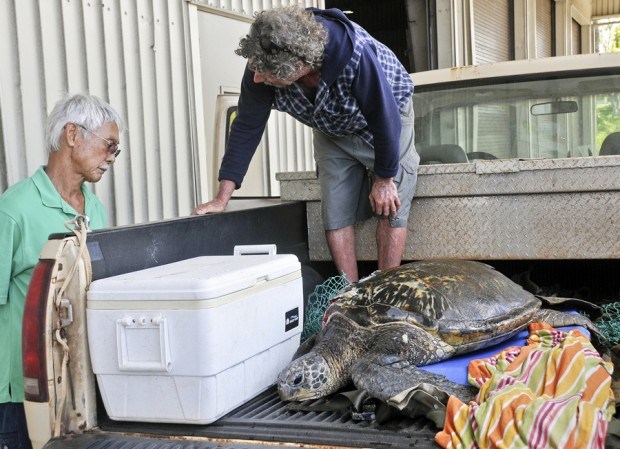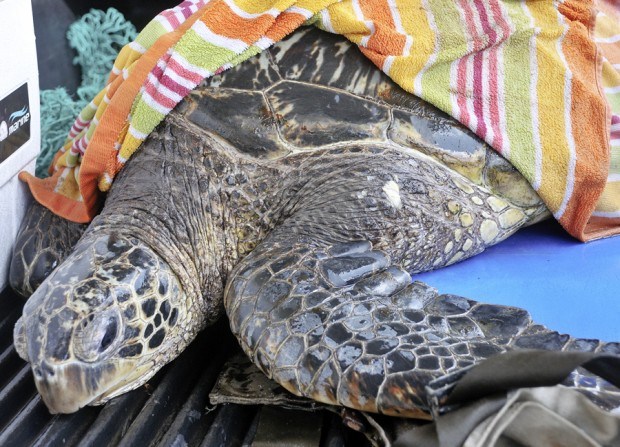LIHU‘E — An injured sea turtle was flown by Aloha Airlines Cargo to O‘ahu for treatment of its wounds Tuesday. The turtle, estimated to be around 25 to 30 years old by the state’s District Fisheries biologist Don Heacock, was
LIHU‘E — An injured sea turtle was flown by Aloha Airlines Cargo to O‘ahu for treatment of its wounds Tuesday.
The turtle, estimated to be around 25 to 30 years old by the state’s District Fisheries biologist Don Heacock, was discovered by an operator aboard Bali Hai Tours Tuesday morning near the Double Caves at Kalala‘u, said Mike Sheehan of Hanalei. Sheehan transported the injured turtle to the Aloha Airlines cargo terminal in Lihu‘e where they were met by Heacock.
“They saw some bubbles in the water and after diving to investigate, discovered the turtle which had sustained propeller strikes,” Sheehan said. “They brought it back to Hanalei and washed out the wound with sea water before transporting.”
Heacock said the turtle sustained perforations in her right lung, her lower intestines are showing and there are indications of five or six propeller strikes on her shell. He called in that assessment to the National Oceanic and Atmospheric Administration Fisheries office.
“Luckily, the propeller missed the turtle’s spine (and) head,” Heacock said. “The turtle is a healthy female and other than signs of a previous encounter with a shark, is fine.”
He said the turtle will be flown to O‘ahu and the care of George Balazs, the NOAA Fisheries Sea Turtle Research lead.
“It has a better than 50/50 chance of recovery,” Heacock said. “If the spinal cord had been damaged, it would have to be euthanized, but because the propeller missed the spine, the turtle will be treated by Dr. Thierry Work, who will surgically repair the perforations in the turtle’s lung, work on the lower intestines, and when the work is done, either fiberglass or install pins in the turtle’s shell.”
Heacock explained that the use of fiberglass and pins are similar to human surgeries and are used to help the area heal from its injuries.
Sheehan’s feat of transporting the injured turtle from Hanalei to Lihu‘e was a Good Samaritan act, Heacock said. Normally, you are not supposed to move an injured turtle which is considered an endangered species, he said. But Sheehan transporting the injured animal was much faster than Heacock having to drive up to Hanalei and transporting the injured turtle back to the airport.
“This is a grim reminder to boaters they need to slow down when around coral, where turtles frequent,” Heacock said. “Either boaters can slow down so turtles can react and avoid them, or go further out beyond the coral.”
He said Hawai‘i should take a lead from Alaska, which has speed limits for boats when they are in the vicinity of endangered species, including whales.
“Turtles sleep and rest at the surface as well,” he said. “Just like humans, while resting, they don’t have time to react to a rapidly approaching vessel. Speed kills on water, just as it does on land.”



